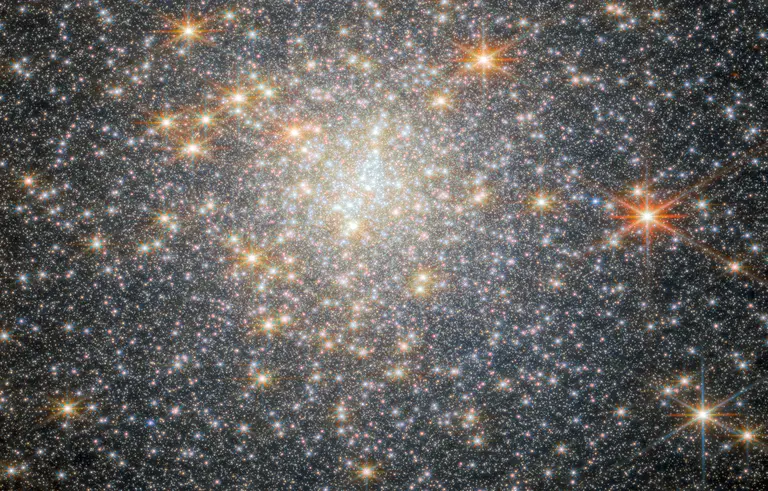Return to All Folder Listing

| Filename | Flickr nasawebbtelescope_53691677609_79de4d06b0_o Star-Studded Cluster (NGC 6440) CC-BY NASA.jpg |
|---|---|
| Desc | This new image from the NASA/ESA/CSA James Webb Space Telescope features NGC 6440, a globular cluster that resides roughly 28 000 light-years from Earth in the constellation Sagittarius. The object was first discovered by William Herschel in May of 1786. Globular clusters like NGC 6440 are roughly spherical, tightly packed, collections of old stars bound together by gravity. They can be found throughout galaxies, but often live on the outskirts. They hold hundreds of thousands to millions of stars that are on average about one light-year apart, but they can be as close together as the size of our Solar System. NGC 6440 is known to be a high-mass and metal-rich cluster that formed and is orbiting within the Galactic bulge, which is a dense, near-spherical region of old stars in the inner part of the Milky Way. This image was obtained with 2023 data from Webb’s Near-InfraRed Camera (NIRCam) as part of an observation programme to explore the stars in the cluster and to investigate details of the cluster’s pulsars. A pulsar is a highly magnetised, rotating neutron star that emits a beam of electromagnetic radiation from their magnetic poles. To us, that beam appears as a short burst or pulse as the star rotates. Pulsars spin extremely fast. Astronomers have clocked the fastest pulsars at more than 716 rotations per second, but a pulsar could theoretically rotate as fast as 1500 rotations per second before slowly losing energy or breaking apart. The new data obtained by the science team indicate the first evidence from Webb observations of abundance variations of helium and oxygen in stars in a globular cluster. These results open the window for future, in-depth investigations of other clusters in the Galactic bulge, which were previously infeasible with other telescope facilities given the significant crowding of stars in the cluster and the strong reddening caused by interstellar dust between the cluster and Earth. [Image Description: A spherical collection of stars which fills the whole view. The cluster is dominated by a concentrated group of bright white stars at the centre, with several large yellow stars scattered throughout the image. Many of the stars have visible diffraction spikes. The background is black.] Links Star studded cluster (NIRCam image wide-field view) Slider tool: Hubble and Webb’s views of NGC 6440 Pan video: NGC 6440 Transition video: Hubble and Webb’s views of NGC 6440 Science paper |
| Type | Photograph |
| Resolution | 3597 x 2300 |
| License | CC-BY |
| Attribution | NASA |
| Collection | thumbs |
| Folder | 01 Genesis/01 Creation/Day 4 Sun Moon Stars/Photographs |
|
Download Medium Download Large Image Source Browse Folder (Medium Resolution) Browse Folder (High Resolution Show in Interactive Search | |
| The Virtual Bible Snapshot Project provides free artwork to illustrate the Bible and Bible topics, including video, photographs, illustrations, and AI Generated artwork. Creative-Commons licensed and public domain sermon graphics for pastors, teachers and more! Learn more at snapshots.vrbm.org. | |